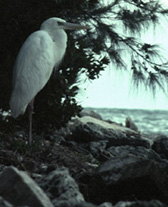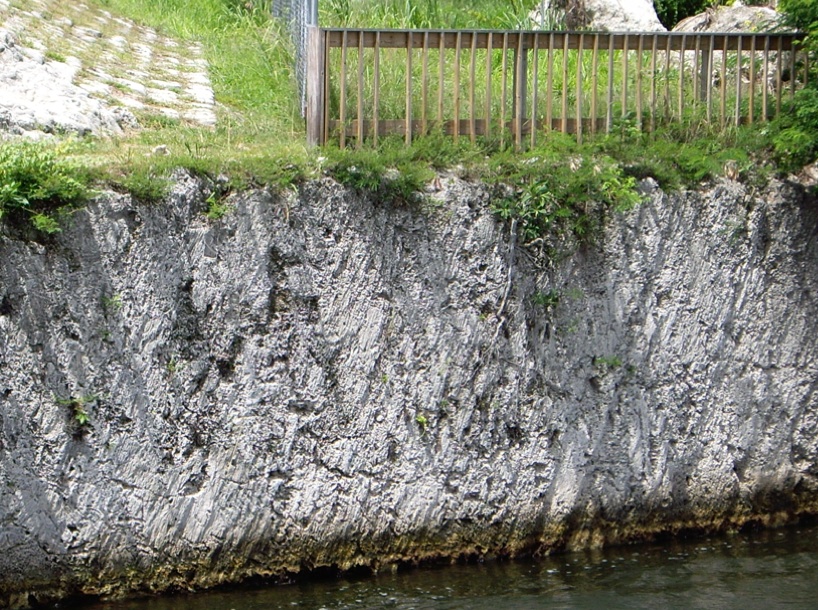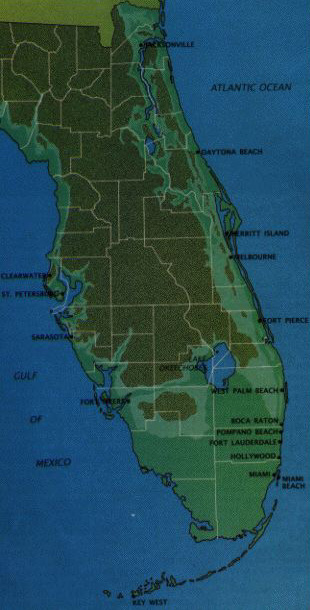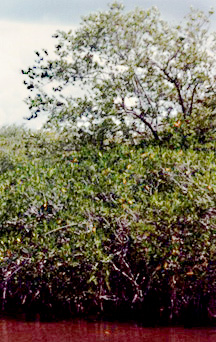| Get
into the Florida Keys and discover... ! |
Florida Bay from Flamingo, ENP. |
yourself. |
| Water, wind, coral and mangrove
conspire here constructing the thinnest imaginable layer of earth
peeking up above the shallow tropical sea. Held together by the
inexorable forces of life clinging to bare rock, marl and fossil
reefs the Florida Keys are a geological testimony to the relentless
ability of life to fashion land out of the sun, the elements,
and the sea. |
 
Key Largo limestone exposed along a channel is made of 10,000 year old reefs |
| Florida's southernmost island chain is called the Keys and the northern extremities visibly reveal the 10,000 year old coral reef that comprise these pearls stretched out in the sun soaked sea. |
| |
 |
| The Florida keys are actually part of
a larger ecosystem stretching from the Florida Straights
to the Everglades and Lake Okeechobee. In a strict geological
sense the keys -- as remnants of a 10,000 year old coral reef
-- are today a series of barrier islands enclosing Florida bay
on the east and south sides and separating the estuary from the
Atlantic Ocean.
|
| Because of their proximity to water
the Keys' mild climate allows the colonization of the land by
tropical vegetation that is otherwise restricted to the Caribbean
shores and the Antilles. The chain of islands comprising the keys
stretches for 180 miles south southwest of Miami and beyond Key
West to the Marquesas and Dry Tortugas island groups. |
 |
Among the most endangered
ecosystems in Florida, three exist in the Keys. These are the
coral reefs off shore, the sea grass beds near shore, and the
tropical hardwood hammock and pine forests where the endangered
key deer hang on to a precarious existence. |
| The Keys are a sunken
treasure -- ecologically speaking -- because the reefs and the
grass flats sustain a rich shrimp, rock lobster and sport fishery
worth billions of dollars annually in tourism and seafood processing.
Tied to the Everglades on the north and the Gulf stream to the
south and east, the keys are our last, best test. If conservation
can not protect the wildlife and fisheries of the Florida keys,
than conservation education has failed to motivate us sufficiently
to comprehend that wealth comes from nature. |
| The keys are a refuge for the itinerant and the mogul alike. |
The keys are a refuge for the itinerant and the mogul alike because climate and weather conspire to sustain regular temperatures above freezing. So much heatis retained in the surrounding waters that beach bathing seems more like a bathtub than an ocean. In extreme summers the coral reefs experience bleaching or the loss of their life sustaining algae because the ocean temperatures rise to high for health reefs to persist.
Harboring fiercely independent fisher folk and resolute environmentalists
these islands represent our last outpost, a sort of high noon
for property rights amidst the "Tragedy of the Commons."
The boundaries in these keys between my land and your land is
not always easy to delineate. The sea
blurs the tideland boundaries and the loss of wildlife and fisheries
blur the fine distinctions between personal responsibility and
community needs. |
| Parts of the keys are as urban as Provincetown,
on Cape Cod, while other keys are as remote as the Galapagos.
Islands in time, the keys are a lasting reminder of what Zora
Neale Hurston said of all Florida. Florida and especially the
keys are "the gift of the sea to the sun." They are
mangrove islets carved out of lime rock and marl by the roar of
hurricanes and the endlessly lapping tides. Mangroves are actually
a collection of four unrelated, yet salt tolerant trees common
in the tropics. They thrive in the Florida Keys due to temperature,
water quality and substrate. These oceanside forests are one of
four biologically productive sources of natural wealth in the
keys. The other sources of biological wealth are the sea grass
beds, the coral reefs and the hardwood tropical forests. |
 |
| The pressure of population growth, pollution and technology
are endangering the wildlife and fisheries of the keys. Yet these
remnants of what Rachel Carson called the Coral Coast are warning
lights along our headlong rush into the future. As Rachel Carson
reminded people nearly forty years ago we need some places to
remind us that our "way is not always best! " |
Many authorities believe the word "key" to be a British corruption
of the Spanish word Cayo referring to something less substantial
in area than an island, or islas. First called the islas de los muertos, on early Spanish charts
because of the shoals and sunken reefs that claimed gold laden ships of the annual Spanish treasure fleets from Veracruz to Seville, in Castile.
|